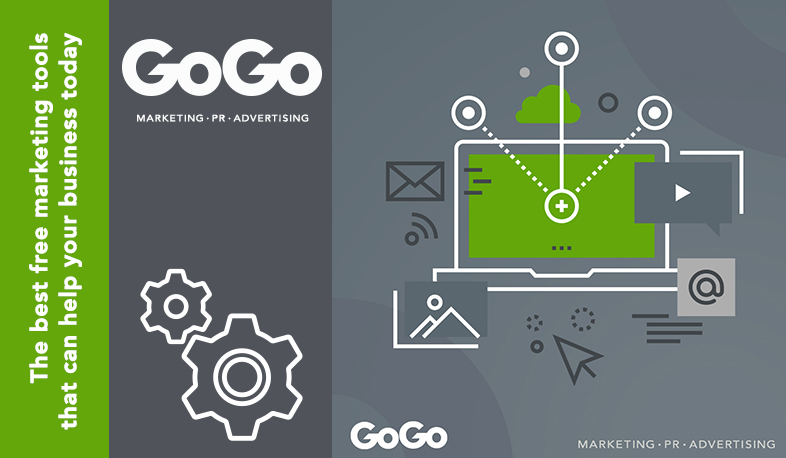We have compiled the enclosed list of recommendations on some of the best free marketing tools for small-to-medium-sized businesses that we feel can help you to communicate to your audiences using an appropriate tone at this time.
1. Email marketing
Email marketing – is the act of targeting audiences with a commercial message through email and is a form of direct marketing.
Mailchimp provides automated emails to make it easy to begin conversations and keep them going with your target audiences. Mailchimp is built as a drag and drop builder for the words and pictures you want to use to make email creation super easy.
2. CRM
Customer Relationship Management (CRM) is an approach to manage a company’s interaction with current and potential customers
Hubspot’s CRM tool allows you to manage your customer data effectively. It lets you build profiles on your customers at a free level so you can track deals, customer interactions, tasks and activities. You can also include free marketing features for your site like forms and email marketing capacity.
Customer data can be overlooked until there is a pressing urgent need to sort it out and maximise on it. This may be a time to invest in your data to identify the correct audience to talk to.
3. Website monitoring, eCommerce and data analysis
Google Analytics is a web analytics service that helps you to understand the metrics to measure your website by and interrogate how it is performing. Analytics can help you identify areas of improvement like bounce rates (when people leave your website straight away) and allows you to interpret these to make improvements to get your site performing. It can also give you eCommerce data, to track sales and revenue generation as well. You can sign up for free training!
4. SEO
Search Engine Optimisation (SEO) is the process of increasing the quality and quantity of website traffic by increasing the visibility of a website or web page to users of a web search engine.
Ubersuggest is a free tool from popular SEO blogger Neil Patel. His team has incorporated loads of features into this free tool to provide insight into how your site performs from an SEO perspective. You can look at top-performing SEO pages, the keywords you rank for, and identify opportunities to explore. It really is worth a look.
5. GRAPHIC DESIGN
Canva offers lots of resources and blogs to help get you started. It’s a great, simple one to get creative with! Canva offers tutorials as well as lots of free resources, but you can also use free imagery sites, such as Gratisography and Unsplash.
Be careful if using images of people or logos. You can use these websites to download royalty-free photos for commercial and non-commercial purposes, and you don’t need permission to provide photography or source credit. But be aware that if you use photos of people or brands/logos, the image could fall under third-party copyright protection – so it’s best avoided.
6. ORGANISATION TOOLS
Evernote or Google Keep are free note-taking tools. They are private, but you can share and edit live with other people. They also offer free templates to get you started and are completely safe and secure.
7. SOCIAL MEDIA
Buffer has a free account available for posting on three channels, with training and articles available to help. It’s effective if you want to manage different accounts across social networks, as well as schedule posts to Twitter, Facebook, Instagram, Instagram Stories, Pinterest and LinkedIn. Use it to analyse your results and engage with your community. You can try Buffer for free for 14 days, and it is reasonably priced if you get on with it well and fancy the full service.
Hootsuite is also a good option. They have great blogs and a free beginner course to get your teeth into using their Hootsuite Academy. Hootsuite’s blog is really useful for answering questions such as, ‘What does that stat mean in a report?’ Or, ‘What image size do I need for this platform?’ There is also more interesting and in-depth information around strategy. Hootsuite has people from all industries using their platforms, so they can pull a lot of great data to showcase how your target audience uses social.
8. COMMUNICATIONS
There are lots of tools out there you could use, but a free and very effective one is Facebook Live. It’s unedited and honest and allows you to connect with your audience straight away. By answering questions that may be asked live by your audience or by having a list of prepared questions at the ready, it’s a very open and human way to connect and communicate.
You can use BuzzSumo to generate ideas, create high-performing content, monitor performance and identify influencers. It’s a good way to talk about the subjects that are relevant right now. Another tool to ensure your headlines are attracting people is CoSchedule, which you can use to make sure you’re showing as high as possible in search results. Finally, Grammarly is a free Google Chrome extension that corrects grammar errors and enhances your writing skills, if you feel this isn’t a strong area for you.
If GoGo can be of any assistance right now, we are offering FREE advice and guidance to any business that needs it to help them through these tough times.
You can contact us via:
- WhatsApp: 07444651148
- ️Twitter Direct Message
- LinkedIn Messenger
- Facebook Messenger
- Phone: 0116 319 1017







